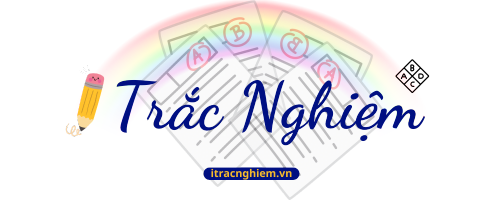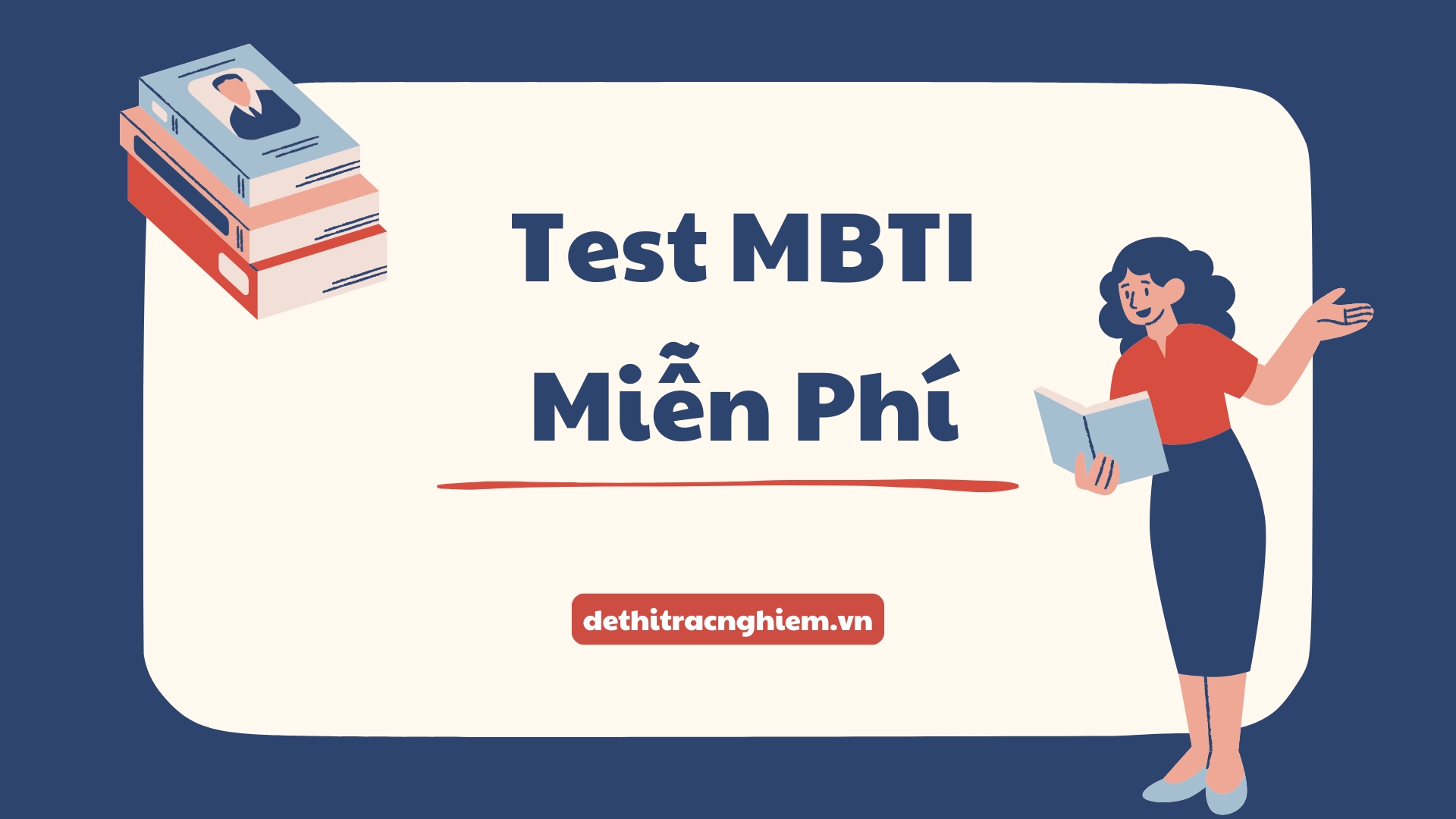Đề thi thử Đại học 2025 môn Tiếng Anh – Sở GD Nam Định là một trong những đề tiêu biểu thuộc Tổng hợp đề thi thử môn Tiếng Anh THPT QG, nằm trong chương trình Đề thi vào Đại học. Được tổ chức bởi Sở Giáo dục và Đào tạo tỉnh Nam Định – một trong những địa phương có truyền thống học tập và luyện thi nghiêm túc – đề thi này là tài liệu tham khảo quan trọng giúp học sinh lớp 12 củng cố kiến thức và làm quen với cấu trúc đề thi tốt nghiệp THPT 2025.
Với độ khó được đánh giá cao và nội dung bám sát đề minh họa của Bộ GD&ĐT, đề thi bao gồm đầy đủ các phần như phát âm, trọng âm, ngữ pháp – từ vựng, chức năng giao tiếp, đọc hiểu và viết lại câu. Những kiến thức trọng tâm như thì động từ, mệnh đề quan hệ, câu điều kiện, đảo ngữ, liên từ – giới từ, idioms, collocations cùng kỹ năng đọc hiểu nhanh và chính xác đều được tích hợp hợp lý. Đây là nguồn luyện đề hữu ích giúp học sinh nâng cao năng lực tiếng Anh tổng thể trước kỳ thi đại học.
Hãy cùng Dethitracnghiem.vn tìm hiểu về đề thi này và tham gia làm kiểm tra ngay lập tức!
- Số trang: 4 trang
- Hình thức: Trắc nghiệm
- Thời gian làm bài: 50 phút (không kể thời gian phát đề)
ĐỀ THI THỬ ĐẠI HỌC MÔN TIẾNG ANH NĂM 2025 SỞ GD NAM ĐỊNH
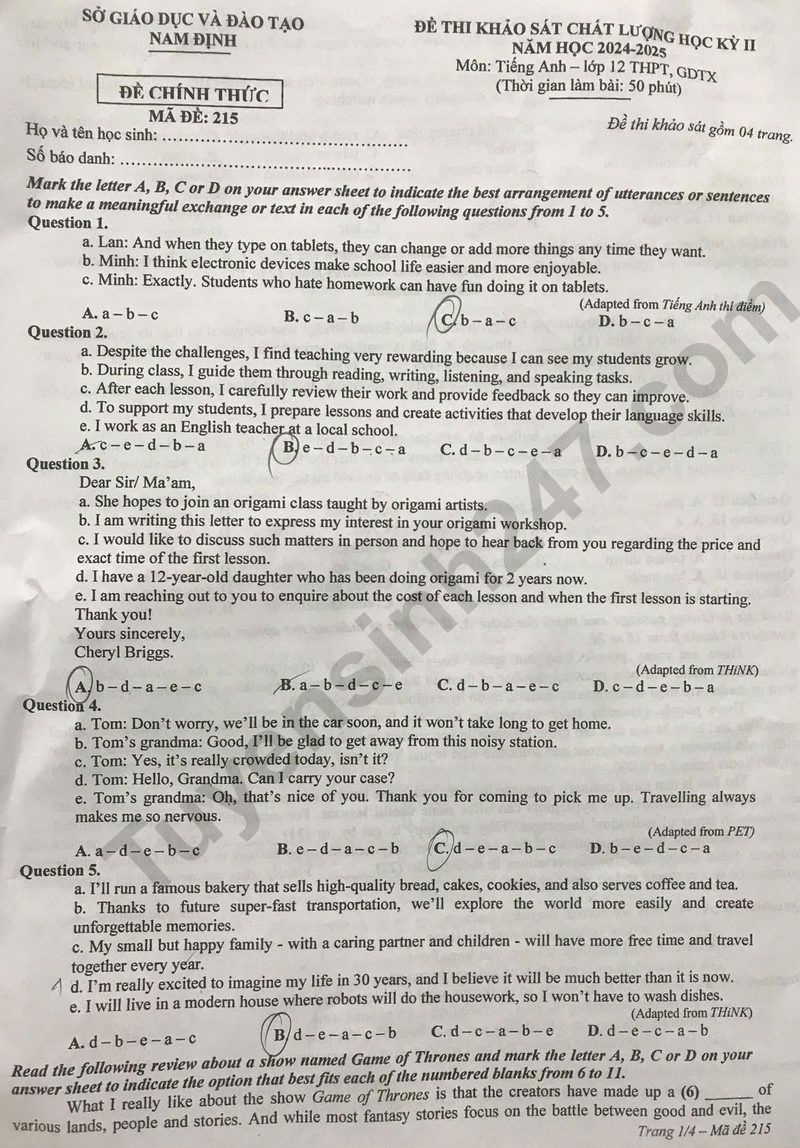
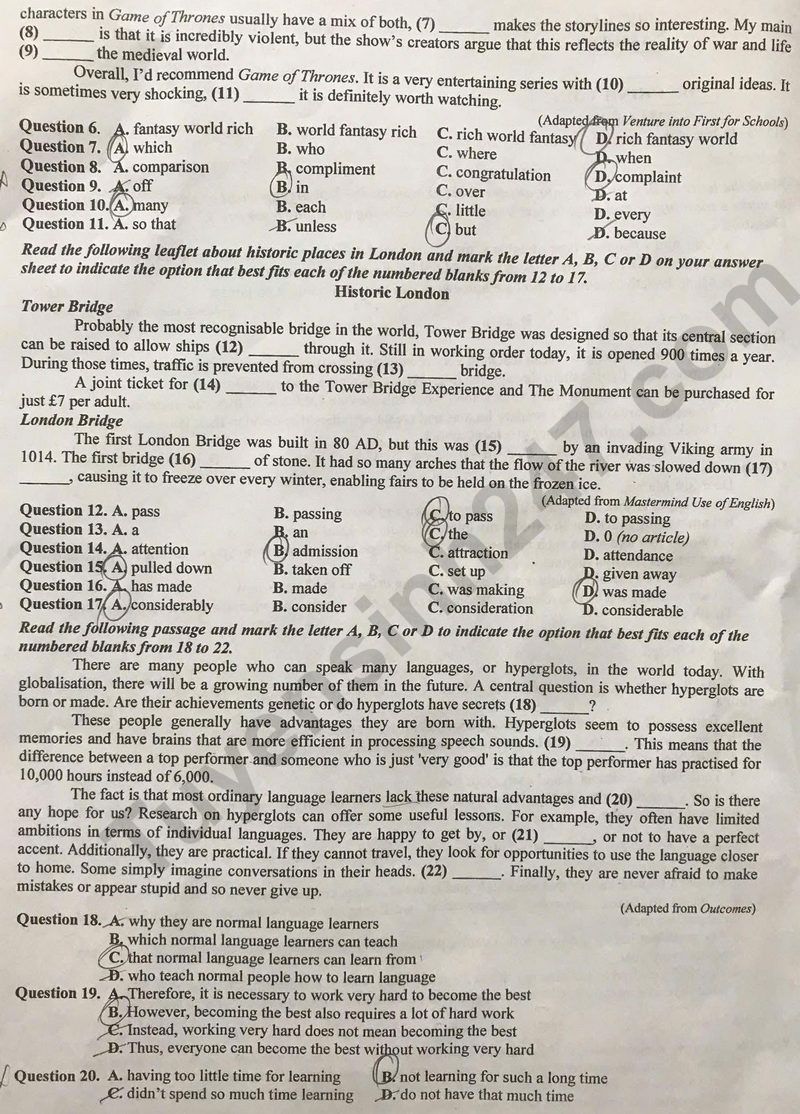
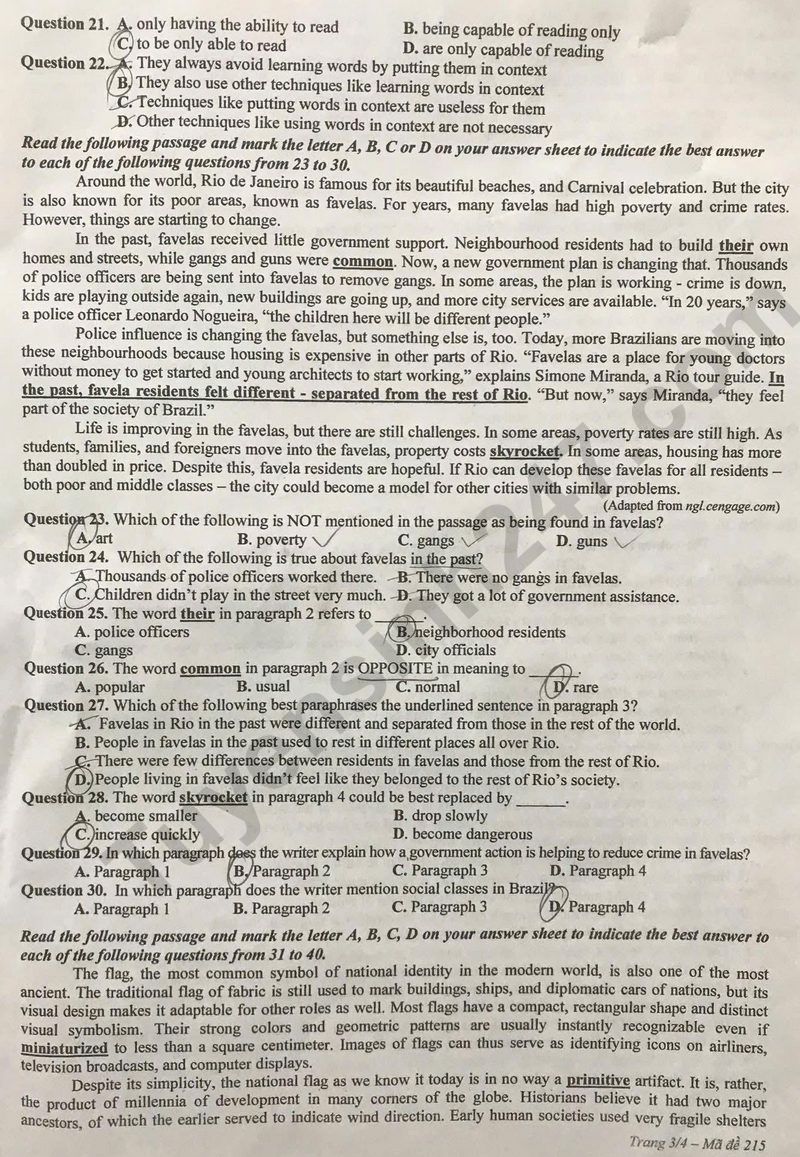
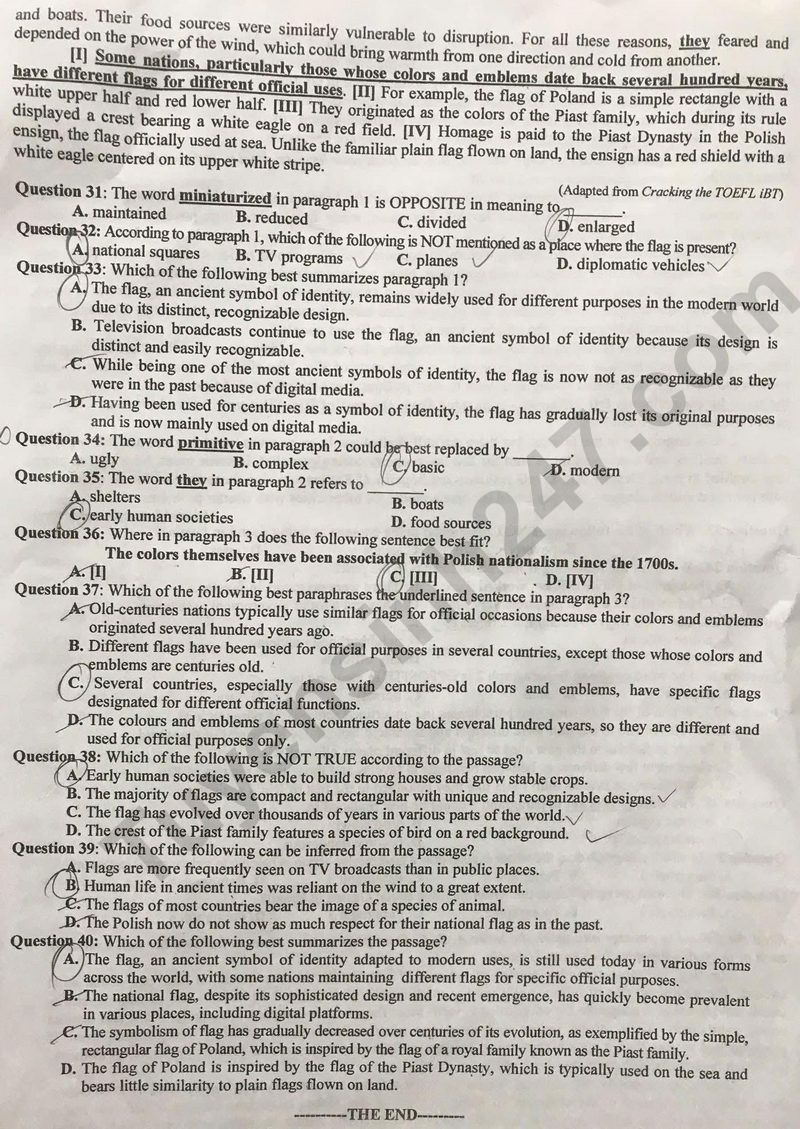
Mark the letter A, B, C, or D on your answer sheet to indicate the best arrangement of utterances or sentences to make a meaningful exchange or text in each of the following questions from 1 to 5.
Question 1:
Lan: And when they type on tablets, they can change or add more things any time they want.
b. Minh: I think electronic devices make school life easier and more enjoyable.
c. Minh: Exactly. Students who hate homework can have fun doing it on tablets.
A. a-b-c
B. c-a-b
C. b-a-c
D. b-c-a
Question 2:
a. Despite the challenges, I find teaching very rewarding because I can see my students grow.
b. During class, I guide them through reading, writing, listening, and speaking tasks.
c. After each lesson, I carefully review their work and provide feedback so they can improve.
d. To support my students, I prepare lessons and create activities that develop their language skills.
e. I work as an English teacher at a local school.
A. c-e-d-b-a
B. e-d-b-c-a
C. d-b-c-e-a
D. b-e-c-d-a
Question 3:
Dear Sir/Ma’am,
a. She hopes to join an origami class taught by origami artists.
b. I am writing this letter to express my interest in your origami workshop.
c. I would like to discuss such matters in person and hope to hear back from you regarding the price and exact time of the first lesson.
d. I have a 12-year-old daughter who has been doing origami for 2 years now.
e. I am reaching out to you to enquire about the cost of each lesson and when the first lesson is starting.
Thank you!
Yours sincerely,
Cheryl Briggs.
A. b-d-a-e-c
B. a-b-d-c-e
C. d-b-a-e-c
D. c-d-e-b-a
Question 4:
a. Tom: Don’t worry, we’ll be in the car soon, and it won’t take long to get home.
b. Tom’s grandma: Good. I’ll be glad to get away from this noisy station.
c. Tom: Yes, it’s really crowded today, isn’t it?
d. Tom: Hello, Grandma. Can I carry your case?
e. Tom’s grandma: Oh, that’s nice of you. Thank you for coming to pick me up. Travelling always makes me so nervous.
A. d-e-c-b-a
B. e-d-a-c-b
C. d-e-a-b-c
D. b-e-d-c-a
Question 5:
a. I’ll run a famous bakery that sells high-quality bread, cakes, cookies, and also serves coffee and tea.
b. Thanks to future super-fast transportation, we’ll explore the world more easily and create unforgettable memories.
c. My small but happy family – with a caring partner and children – will have more free time and travel together every year.
d. I’m really excited to imagine my life in 30 years, and I believe it will be much better than it is now.
e. I will live in a modern house where robots will do the housework, so I won’t have to wash dishes.
A. d-b-e-c-a
B. d-e-a-c-b
C. d-c-a-b-e
D. d-e-c-a-b
Read the following review about a show named Game of Thrones and mark the letter A, B, C, or D on your answer sheet to indicate the option that best fits each of the numbered blanks from 6 to 11.
What I really like about the show Game of Thrones is that the creators have made up a (6) _______ of different worlds, people and stories. And while most fantasy stories focus on the battle between good and evil, the characters in Game of Thrones usually have a mix of both. (7) _______ makes the storylines so interesting. My main (8) _______ is that it is incredibly violent, but the show’s creators argue that this reflects the reality of war and life in (9) _______ the medieval world. Overall, I’d recommend Game of Thrones. It is a very entertaining series with (10) _______ original ideas. It is sometimes very shocking, (11) _______ it is definitely worth watching.
Question 6:
A. fantasy world rich
B. world fantasy rich
C. rich world fantasy
D. rich fantasy world
Question 7:
A. which
B. who
C. where
D. when
Question 8:
A. comparison
B. compliment
C. congratulation
D. complaint
Question 9:
A. off
B. in
C. over
D. at
Question 10:
A. so many
B. each
C. little
D. every
Question 11:
A. so that
B. unless
C. but
D. because
Read the following leaflet about historic places in London and mark the letter A, B, C, or D on your answer sheet to indicate the option that best fits each of the numbered blanks from 12 to 17.
Tower Bridge
Probably the most recognisable bridge in the world, Tower Bridge was designed so that its central section can be raised to allow ships (12) _______ through it. Still in working order today, it is opened 900 times a year. During those times, traffic is prevented from crossing (13) _______ bridge.
A joint ticket for (14) _______ to the Tower Bridge Experience and The Monument can be purchased for just £7 per adult.
London Bridge
The first London Bridge was built in 80 AD, but this was (15) _______ by an invading Viking army in 1014. The first bridge (16) _______ of stone. It had so many arches that the flow of the river was slowed down (17) _______ causing it to freeze over every winter, enabling fairs to be held on the frozen ice.
Question 12:
A. pass
B. passing
C. to pass
D. to passing
Question 13:
A. a
B. an
C. the
D. 0 (no article)
Question 14:
A. attention
B. admission
C. attraction
D. attendance
Question 15:
A. pulled down
B. taken off
C. set up
D. given away
Question 16:
A. has made
B. made
C. was making
D. was made
Question 17:
A. considerably
B. consider
C. consideration
D. considerable
Read the following passage and mark the letter A, B, C or D to indicate the option that best fits each of the numbered blanks from 18 to 22.
There are many people who can speak many languages, or hyperglots, in the world today. With globalisation, there will be a growing number of them in the future. A central question is whether hyperglots are born or made. Are their achievements genetic or do hyperglots have secrets (18) _______?
These people generally have advantages they are born with. Hyperglots seem to possess excellent memories and have brains that are more efficient in processing speech sounds. (19) _______ This means that the difference between a top performer and someone who is just very good is that the top performer has practised for 10,000 hours instead of 6,000.
The fact is that most ordinary language learners lack these natural advantages and (20) _______. So is there any hope for us? Research on hyperglots can offer some useful lessons. For example, they often have limited ambitions in terms of individual languages. They are happy to get by, or (21) _______, or not to have a perfect accent. Additionally, they are practical. If they cannot travel, they look for opportunities to use the language closer to home. Some simply imagine conversations in their heads. (22) _______ Finally, they are never afraid to make mistakes or appear stupid and so never give up.
Question 18:
A. why they are normal language learners
B. which normal language learners can teach
C. that normal language learners can learn
D. how normal people learn language
Question 19:
A. Therefore, it is still the best way to learn
B. However, becoming the best also requires a lot of hard work
C. Instead, working very hard does not mean becoming the best
D. Thus, everyone can become the best without working very hard
Question 20:
A. having too little time for learning
B. not learning for such a long time
C. didn’t spend so much time learning
D. do not have that much time
Question 21:
A. only having the ability to read
B. being capable of reading only
C. to be only able to read
D. are only capable of reading
Question 22:
A. They always avoid learning words by putting them in context
B. They also always read by learning new words in context
C. They also use other techniques like learning words in context
D. Techniques like putting words in context are useless for them
Read the following passage and mark the letter A, B, C or D on your answer sheet to indicate the best answer to each of the questions from 23 to 30.
Around the world, Rio de Janeiro is famous for its beautiful beaches, and Carnival celebration. But the city is also known for its poor areas, known as favelas. For years, many favelas had high poverty and crime rates. However, things are starting to change.
In the past, favelas received little government support. Neighbourhood residents had to build their own homes and streets, while gangs and guns were common. Now, a new government plan is changing that. Thousands of police officers are being sent into favelas to remove gangs. In some areas, the plan is working – crime is down, kids are playing outside again, new buildings are going up, and more city services are available. “In 20 years,” says a police officer Leonardo Nogueira, “the children here will be different people.”
Police influence is changing the favelas, but something else is, too. Today, more Brazilians are moving into these neighbourhoods because housing is expensive in other parts of Rio. “Favelas are a place for young doctors without money to get started and young architects to start working,” explains Simone Miranda, a Rio tour guide. In the past, favela residents felt different – separated from the rest of Rio. “But now,” says Miranda, “they feel part of the society of Brazil.”
Life is improving in the favelas, but there are still challenges. In some areas, poverty rates are still high. As students, families, and foreigners move into the favelas, property costs skyrocket. In some areas, housing has more than doubled in price. Despite this, favela residents are hopeful. If Rio can develop these favelas for all residents – both poor and middle classes – the city could become a model for other cities with similar problems.
Question 23: Which of the following is NOT mentioned in the passage as being found in favelas?
A. art
B. poverty
C. gangs
D. guns
Question 24: Which of the following is true about favelas in the past?
A. Thousands of police officers worked there.
B. There were no gangs in favelas.
C. Children didn’t play in the street very much.
D. They got a lot of government assistance.
Question 25: The word “their” in paragraph 2 refers to _______.
A. police officers
B. neighbourhood residents
C. gangs
D. city officials
Question 26: The word “common” in paragraph 2 is OPPOSITE in meaning to _______.
A. popular
B. usual
C. normal
D. rare
Question 27: Which of the following best paraphrases the underlined sentence in paragraph 3?
“In the past, favela residents felt different – separated from the rest of Rio.”
A. Favelas in Rio in the past were different and separated from those in the rest of the world.
B. People in favelas in the past used to rest in different places all over Rio.
C. There were few differences between residents in favelas and those from the rest of Rio.
D. People living in favelas didn’t feel like they belonged to the rest of Rio’s society.
Question 28: The word “skyrocket” in paragraph 4 could be best replaced by _______.
A. become smaller
B. drop slowly
C. increase quickly
D. become dangerous
Question 29: In which paragraph does the writer explain how a government action is helping to reduce crime in favelas?
A. Paragraph 1
B. Paragraph 2
C. Paragraph 3
D. Paragraph 4
Question 30: In which paragraph does the writer mention some social classes in Brazil?
A. Paragraph 1
B. Paragraph 2
C. Paragraph 3
D. Paragraph 4
Read the following passage and mark the letter A, B, C, or D on your answer sheet to indicate the best answer to each of the questions from 31 to 40.
The flag, the most common symbol of national identity in the modern world, is also one of the most ancient. The traditional flag of fabric is still used to mark buildings, ships, and diplomatic cars of nations, but its visual design makes it adaptable for other roles as well. Most flags have a compact, rectangular shape and distinct visual symbolism. Their strong colors and geometric patterns are usually instantly recognizable even if miniaturized to less than a square centimeter. Images of flags can thus serve as identifying icons on airliners, television broadcasts, and computer displays.
Despite its simplicity, the national flag as we know it today is in no way a primitive artifact. It is, rather, the product of millennia of development in many corners of the globe. Historians believe it had two major ancestors, of which the earlier served to indicate wind direction. Early human societies used very fragile shelters and boats. Their food sources were similarly vulnerable to disruption. For all these reasons, they feared and depended on the power of the wind, which could bring warmth from one direction and cold from another.
Some nations, particularly those whose colors and emblems date back several hundred years, have different flags for different official uses. [I] For example, the flag of Poland is a simple rectangle with a white upper half and red lower half. [II] It originated as the colors of the Piast family, which during its rule displayed a crest bearing a white eagle on a red field. [IV] Homage is paid to the Piast dynasty in the Polish ensign, the flag officially used at sea. Unlike the familiar plain flag flown on land, the ensign has a red shield with a white eagle centered on its upper white stripe.
Question 31: The word “miniaturized” in paragraph 1 is OPPOSITE in meaning to _______.
A. maintained
B. reduced
C. divided
D. enlarged
Question 32: According to paragraph 1, which of the following is NOT mentioned as a place where the flag is present?
A. national squares
B. TV programs
C. planes
D. diplomatic vehicles
Question 33: Which of the following best summarizes paragraph 1?
A. The flag, an ancient symbol of identity, remains widely used for different purposes in the modern world due to its distinct, recognizable design.
B. Television broadcasts continue to use the flag, an ancient symbol of identity because its design is distinct and easily recognizable.
C. While being one of the most ancient symbols of identity, the flag is now not as recognizable as they were in the past because of digital media.
D. Having been used for centuries as a symbol of identity, the flag has gradually lost its original purposes and is now mainly used on digital media.
Question 34: The word “primitive” in paragraph 2 could be best replaced by _______.
A. ugly
B. complex
C. basic
D. modern
Question 35: The word “they” in paragraph 2 refers to _______.
A. shelters
B. boats
C. early human societies
D. food sources
Question 36: Where in paragraph 3 does the following sentence best fit?
“The colors themselves have been associated with Polish nationalism since the 1700s.”
A. [I]
B. [II]
C. [III]
D. [IV]
Question 37: Which of the following best paraphrases the underlined sentence in paragraph 3?
“Some nations, particularly those whose colors and emblems date back several hundred years, have different flags for different official uses.”
A. Old-centuries nations typically use similar flags for official occasions because their colors and emblems originated several hundred years ago.
B. Different flags have been used for official purposes in several countries, except those whose colors and emblems are centuries old.
C. Several countries, especially those with centuries-old colors and emblems, have specific flags designated for different official functions.
D. The colours and emblems of most countries date back several hundred years, so they are different and used for official purposes only.
Question 38: Which of the following is NOT TRUE according to the passage?
A. Early human societies were able to build strong houses and grow stable crops.
B. The majority of flags are compact and rectangular with unique and recognizable designs.
C. The flag has evolved over thousands of years in various parts of the world.
D. The crest of the Piast family features a species of bird on a red background.
Question 39: Which of the following can be inferred from the passage?
A. Flags are more frequently seen on TV broadcasts than in public places.
B. Human life in ancient times was reliant on the wind to a great extent.
C. The flags of most countries bear the image of a species of animal.
D. The Polish now do not show as much respect for their national flag as in the past.
Question 40: Which of the following best summarizes the passage?
A. The flag, an ancient symbol of identity, adapted to modern uses, is still used today in various forms across the world, with some nations maintaining different flags for specific official purposes.
B. The national flag, despite its sophisticated design and recent emergence, has quickly become prevalent in various places, including digital platforms.
C. The symbolism of the flag has gradually decreased over centuries of its evolution, as exemplified by the simple, rectangular flag of Poland, which is inspired by the flag of a royal family known as the Piast Family.
D. The flag of Poland is inspired by the flag of the Piast Dynasty, which is typically used on the sea and bears little similarity to plain flags flown on land.
Mục đích tổ chức kỳ thi Đại học năm 2025 là gì?
Căn cứ theo quy chế hiện hành của Bộ Giáo dục và Đào tạo và các văn bản hướng dẫn tổ chức kỳ thi Đại học năm 2025, mục đích của kỳ thi là:
– Đánh giá kết quả học tập của học sinh sau 12 năm học theo yêu cầu của chương trình giáo dục phổ thông.
– Lấy kết quả thi để xét công nhận tốt nghiệp trung học phổ thông và làm căn cứ tuyển sinh đại học, cao đẳng.
– Góp phần đánh giá chất lượng giáo dục của địa phương và cả nước, làm cơ sở điều chỉnh nội dung, phương pháp dạy học trong nhà trường.
Thí sinh thi Đại học năm 2025 có bắt buộc thi môn Tiếng Anh không?
Theo quy định hiện hành của Bộ Giáo dục và Đào tạo và hướng dẫn tổ chức kỳ thi tốt nghiệp Đại học năm 2025, thí sinh dự thi phải thực hiện như sau:
– Thi 3 môn bắt buộc: Toán, Ngữ văn và Ngoại ngữ.
– Ngoài ra, thí sinh phải chọn một trong hai bài thi tổ hợp: Khoa học Tự nhiên (gồm các môn Vật lí, Hóa học, Sinh học) hoặc Khoa học Xã hội (gồm các môn Lịch sử, Địa lí, Giáo dục công dân – dành cho học sinh học chương trình giáo dục phổ thông).
Trong số các môn thi, Tiếng Anh là một trong ba môn thuộc bài thi Ngoại ngữ bắt buộc, thí sinh phải thi môn Tiếng Anh như một môn bắt buộc, không phụ thuộc vào lựa chọn bài thi tổ hợp hay mục đích xét tuyển đại học.
Như vậy, kỳ thi Đại học năm 2025 bắt buộc thí sinh phải thi môn Tiếng Anh.
